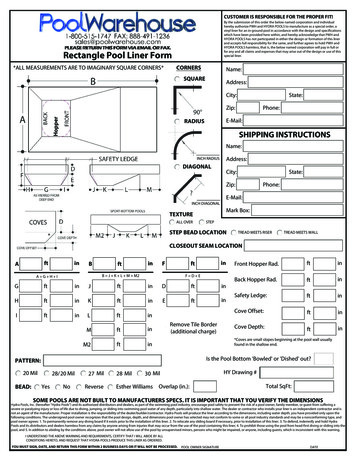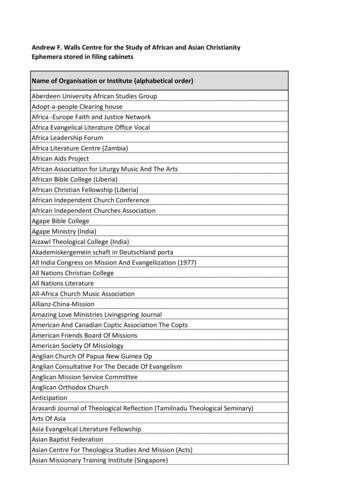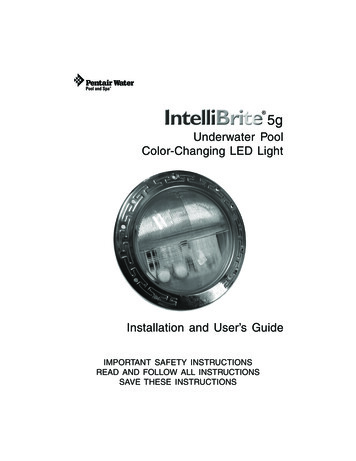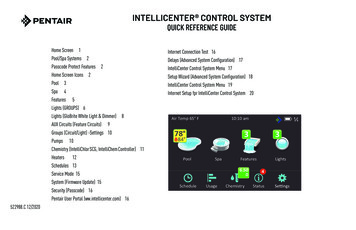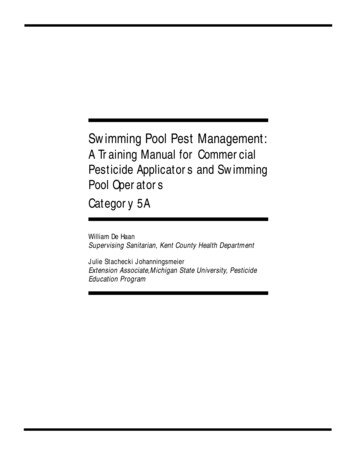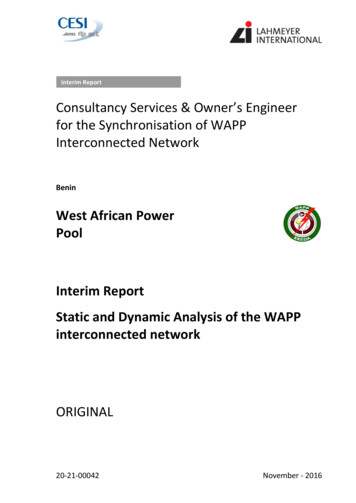
Transcription
Interim ReportConsultancy Services & Owner’s Engineerfor the Synchronisation of WAPPInterconnected NetworkBeninWest African PowerPoolInterim ReportStatic and Dynamic Analysis of the WAPPinterconnected networkORIGINAL20-21-00042November - 2016
Interim ReportConsultancy Services & Owner’s Engineerfor the Synchronisation of WAPPInterconnected NetworkBeninWest African PowerPoolInterim ReportStatic and Dynamic Analysis of the WAPPinterconnected networkCOPY20-21-00042November - 2016
Joint Venture Lahmeyer International GmbH and CESI SpA, 2015 (JV LI-CESI)The information contained in this document is solely for the use of the Client identified on the cover sheet for the purpose for which it has been prepared.JV LI-CESI undertakes no duty to or accepts any responsibility to any third party who may rely uponthis document.All rights reserved. No section or element of this document may be removed from this document,reproduced, electronically stored or transmitted in any form without written permission of JV LICESI.20-21-00042November - 2016
Consultancy Services & Owner’s Engineerfor the Synchronisation of WAPPInterconnected NetworkBeninPrepared for:West African Power Pool (WAPP)Zone des Ambassades, PK-606 BP 2907Cotonou – BeninPrepared by:Joint Venture Lahmeyer International GmbH and CESI SpAc/o lahmeyer International GmbHFriedberger Straße 17361118 Bad VilbelGermanyInspection status:Revision 1Revision History:Revision DateAuthorChecked byRev. 0Rev. 1M. CignattaS. PasquiniF. ParmaD. Provenzano R. GraefenM. StoriE. Kleine12/09/201630/11/201620-21-00042Approved byDescriptionNovember - 2016
Table of Contents1234INTRODUCTION . 11OVERVIEW OF THE ANALYSES . 122.1 Scenarios . 13STEADY STATE ANALYSIS . 143.1 Methodology . 143.1.1 Contingency analysis.143.1.2 Voltage sensitivity analysis .153.1.3 Short circuit currents assessment .163.2 Results – 2016 Scenarios . 183.2.1 Results of Contingency Analysis – 2016 Scenarios .193.2.2 Sensitivity Analysis - 2016 Scenarios .313.2.3 Short Circuit Currents Assessment – 2016 Scenarios .323.3 Proposed short-term reinforcements from static analysis on 2016scenarios . 363.4 Results – 2020 Scenarios . 373.4.1 Results of Contingency Analysis – 2020 Scenarios .413.4.2 Sensitivity Analysis - 2020 Scenarios .473.4.3 Short Circuit Currents Assessment – 2020 Scenarios .493.5 Proposed medium-term reinforcements from static analysis on 2020scenarios . 55DYNAMIC ANALYSIS . 564.1 SMALL SIGNAL STABILITY ANALYSIS. 564.1.1 GENERALITIES AND SCOPE OF WORK .564.1.2 VALIDATION OF POWERFACTORY NETWORK MODEL .604.1.3 RESULTS .604.1.4 CONCLUSIONS.724.2 DYNAMIC SECURITY ASSESSMENT AND DEFENCE PLAN . 774.2.1 Analysis Result – 2016 Scenarios .794.2.2 Analysis Result – 2020 Scenarios .1004.3 TRANSIENT STABILITY .1114.3.1 Methodology .1114.3.2 Analysis Result – 2016 Scenarios .1154.3.3 Analysis Result – 2020 Scenarios .1324.4 Proposed short-term reinforcements according to dynamic analysison 2016 scenarios .135Consultancy Services & Owner’s Engineer for the Synchronisationof WAPP Interconnected NetworkStatic and dynamic analysis of WAPP interconnected networkNovember - 2016page i of x
4.54.64.74.84.956789UFLS Harmonization.136General consideration on system protections .137General considerations on UVLS .138Back-to-Back HVDC alternative at Sakété.139Proposed medium-term reinforcements according to dynamicanalysis on 2020 scenarios .140WAMS STUDY FOR WAPP NETWORK .1415.1 Scope of WAMS technology .1415.2 Introduction to PMU devices selection and their positioning strategy .1425.3 WAPP PMU positioning solutions .1435.3.1 Solution 1 – 2016 .1435.3.2 Solution 2 – 2016 .1445.3.3 Solution 3 – 2016 .1465.3.4 Solution 1 – 2020 .1495.3.5 Solution 2 – 2020 .1515.3.6 Solution 3 – 2020 .1535.4 Future steps for WAMS deployment .1595.4.1 Telecommunication system improvement .1595.4.2 WAMS applications implementation .159BACK-TO-BACK ALTERNATIVE ANALYSIS AT SAKETE SUBSTATION .1616.1 HVDC station technologies .1616.1.1 LCC technology .1616.1.2 VSC technology .1636.2 Technical Evaluation .1666.2.1 Effective short circuit ratio .1676.2.2 Summary of Technical Evaluation.168DEFINITION OF THE NECESSARY REINFORCEMENTS AND COST ESTIMATION .1707.1 Economical Evaluation of the back-to-back at Sakété substation .1707.1.1 Final investment Evaluation .1777.2 Economic evaluation of reactive compensations .1777.2.1 SVC: Static Var Compensator .1777.2.2 Shunt and Series Compensation .1807.3 Economic considerations on PSS .1867.4 Economic considerations on protections.1867.5 Summary of estimated Investments .187REFERENCES .189ANNEXES .191Consultancy Services & Owner’s Engineer for the Synchronisationof WAPP Interconnected NetworkStatic and dynamic analysis of WAPP interconnected networkNovember - 2016page ii of x
List of TablesTable 2.1:List of Scenarios .13Table 3.1:Operational limits .14Table 3.2:Breaking Capacity – Typical Values by Voltage Level .17Table 3.3:2016 peak load scenario characteristics.18Table 3.4:2016 off-peak load scenario characteristics .19Table 3.5:scenariosContingencies and violations not significantly impacting the interconnections – 201620Table 3.6:Critical contingencies with direct impact on the interconnections – 2016 scenarios .23Table 3.7:Results of the dynamic contingency analysis for the critical contingencies .25Table 3.8:Candidate Buses for the SOGEM area .31Table 3.9:Candidate Buses for the NIGELEC-FLEUVE area .31Table 3.10:Candidate Buses for the NIGELEC-NCE area .31Table 3.11:2016 Peak and Off Peak Scenarios – Short circuit currents on the WAPPInterconnection buses.33Table 3.12:2016 Peak and Off Peak Scenarios – Buses above 90 kV with short circuitcurrents violating the breaking capacity .34Table 3.13:2020 peak load scenario characteristics .37Table 3.14:2020 off-peak load scenario characteristics .38Table 3.15:CEB/SONABEL)Reactive compensation in the North-Core and Niger Networks (NIGELEC/39Table 3.16:Additional Reactive Compensation in the WAPP Network .39Table 3.17:2020 scenariosContingencies and violations not significantly impacting the interconnections–41Table 3.18:scenariosCritical contingencies with direct impact on the interconnections – 202045Consultancy Services & Owner’s Engineer for the Synchronisationof WAPP Interconnected NetworkStatic and dynamic analysis of WAPP interconnected networkNovember - 2016page iii of x
Table 3.19:scenarios)Results of the dynamic contingency analysis for the critical contingencies (202045Table 3.20:Candidate Buses for the SOGEM area .47Table 3.21:Candidate Buses for the NIGELEC-FLEUVE area .47Table 3.22:Candidate Buses for the NIGELEC-NCE area .48Table 3.23:2020 Peak and Off Peak Scenarios – Short circuit currents on the WAPPInterconnection buses.50Table 3.24:2020 Peak and Off Peak Scenarios – Buses above 90 kV with short circuitcurrents violating the breaking capacity .53Table 4.1:Inter-area modes for 2016 peak scenario .61Table 4.2:Inter-area modes for 2016 peak interconnected scenario.63Table 4.3:Inter-area modes for 2016 off peak scenario .64Table 4.4:Inter-area modes for 2016 off peak interconnected scenario .65Table 4.5:Inter-area modes for 2020 peak scenario .67Table 4.6:Inter-area modes for 2020 off-peak scenario.68Table 4.7:Generating units with the highest participation in local modes for the 2016 scenarios69Table 4.8:Generating units with the highest participation in local modes for the 2020 scenarios70Table 4.9:Most important interarea modes in 2016 scenarios .73Table 4.10:Most important interarea modes in 2020 scenarios .76Table 4.11:Main results of generation trip for 2016 base scenarios.79Table 4.12:Main results of branch trip for 2016 base scenarios .80Table 4.13:Main results of generation trip for 2016 interconnected reinforced scenarios84Table 4.14:Main results of branch trip for 2016 interconnected reinforced scenarios .85Table 4.15:Contingency Katsina – Gazaoua 132 kV line (TCN/NIGELEC).89Table 4.16:Contingency Bakel – Kayes 225 kV line (SOGEM) .90Consultancy Services & Owner’s Engineer for the Synchronisationof WAPP Interconnected NetworkStatic and dynamic analysis of WAPP interconnected networkNovember - 2016page iv of x
Table 4.17:Contingency B.Kebbi – Kainji 330 kV line (TCN).93Table 4.18:Contingency Kaduna – Kano 330 kV line (TCN) .95Table 4.19:Contingency Ferké – Bouake 2 225 kV line (CIE) .97Table 4.20:Contingency Kaduna 330 kV (TCN) .99Table 4.21:Main results of generation trip for 2020 scenarios .100Table 4.22:Main results of branch trip for 2020 scenarios .103Table 4.23:Contingency Kodeni 225 kV (SONABEL).107Table 4.24:Contingency Goroubanda – Salkadamna 330 kV line (NIGELEC).109Table 4.25:Results of CCT calculation for 2016 scenarios .116Table 4.26:Summary of results of Maximum Transfer Limits – Peak Scenario 2016 .120Table 4.27:Summary of results of Maximum Transfer Limits – Off-Peak Scenario 2016 126Table 4.28:Summary of results of Maximum Transfer Limits (2020) .132Table 4.29:Proposed harmonized UFLS stages .136Table 4.30:Provided protections installed on WAPP interconnections .137Table 5.1:Nodes to be equipped with PMUs to monitor interconnections in 2016 WAPP network143Table 5.2: Nodes to be equipped with PMUs to monitor nodes characterized by a high value ofobservability .145Table 5.3:nodeNodes located near to important generators – More than 150MVA connected to the146Table 5.4:nodeNodes located near to important power plants – More than 150MVA connected to the148Table 5.5:Nodes to be equipped with PMUs to monitor interconnections in 2020 WAPP network150Table 5.6: Nodes to be equipped with PMUs to monitor nodes characterized by a high value ofobservability .152Table 5.7:Nodes of important generators – More than 150MVA .153Consultancy Services & Owner’s Engineer for the Synchronisationof WAPP Interconnected NetworkStatic and dynamic analysis of WAPP interconnected networkNovember - 2016page v of x
Table 5.8:Nodes located near to important power plants – More than 150MVA .156Table 6.1:LCC and VSC technology Summary .164Table 6.2:Examples of projects in different DC technologies .166Table 6.3:Short Circuit Power level at Saketé Station .167Table 6.4:ESCR Calculated Values.168Table 6.5:Technology dependent inherent functionality .168Table 6.6:Summary of Technical Evaluation .169Table 7.1:Costs of Converter Stations obtained by JWG-B2.B4.C1.17 from manufacturersFOB (2007) [19][20] 170Table 7.2: Investment Cost of Station USD Million (492 CIGRE’ VSC- HVDC for Power Transmission2012) [18] 170Table 7.3:BTB system investment cost (CESI Study 2015) .171Table 7.4:[22]Cost of VSC Converter Station (Electricity Ten Year Statement 2015 – National Grid)171Table 7.5:BTB system investment cost (CESI Study 2016) .171Table 7.6:Breakdown of VSC BTB components costs (CESI Study 2016).172Table 7.7:VSC BTB Cost Equation Investment Estimate .173Table 7.8:VSC BTB Investment Estimate Summary .174Table 7.9:VSC BTB Estimated time to commissioning .174Table 7.10:Breakdown of LCC BTB components costs (HVDC Transmission 2009).174Table 7.11:LCC BTB Cost Equation Investment Estimate .175Table 7.12:LCC BTB Investment Estimate Summary .176Table 7.13:LCC BTB Estimated time to commissioning .176Table 7.14:LCC vs VSC Investment Comparison .177Table 7.15:SVC Costs Trend ( JRC ETRI 2014) [21] .178Table 7.16:Cost comparison of various facts device (IJSRP - 2013).178Consultancy Services & Owner’s Engineer for the Synchronisationof WAPP Interconnected NetworkStatic and dynamic analysis of WAPP interconnected networkNovember - 2016page vi of x
Table 7.17:Investment cost ranges for FACTS (ERSE, JRC - 2010) [26] .179Table 7.18:SVC Cost (Exponent Report - 2016) [25] .179Table 7.19:SVC Cost Pakistan transmission Project (ADB - 2012) [24] .179Table 7.20:SVC Cost New Mexico Project (Cargill Power Markets – 2014) [23] .179Table 7.21:SVC Economic Estimate .180Table 7.22:SVC Investments Estimate .180Table 7.23:Bus Reactor Investment Cost (National Grid 2014) [28] .181Table 7.24:Shunt Reactors Cost (Electricity Ten Year Statement 2015 – National Grid) [22]181Table 7.25:Shunt Reactors Cost WB Turkey Project 2015 [29] .181Table 7.26:Shunt Reactor Economic Estimate.182Table 7.27:Line Capacitor Investment Cost (CESI Study 2016).182Table 7.28:Line Capacitor Investment Cost (CESI Study 2014).183Table 7.29:Grid) [22]Series Compensation Cost (Electricity Ten Year Statement 2015 – National183Table 7.30:Series Capacitor Economic Estimate.183Table 7.31:Goroubanda – Ouaga Est 330 kV Reinforcement costs .184Table 7.32:Goroubanda – Salkadamna 330 kV Reinforcement costs 9 .184Table 7.33:Goroubanda – Zabori 330 kV Reinforcement costs 9 .184Table 7.34:Salkadamna Substation Reinforcement costs .184Table 7.35:Goroubanda Substation Reinforcement costs.185Table 7.36:Zabori Substation Reinforcement costs.185Table 7.37:Ouaga Est Substation Reinforcement costs .185Table 7.38:Malanville Substation Reinforcement costs .185Table 7.39:Overall Reinforcement Costs (2020) .185Consultancy Services & Owner’s Engineer for the Synchronisationof WAPP Interconnected NetworkStatic and dynamic analysis of WAPP interconnected networkNovember - 2016 page vii of x
Table 7.40:Estimated Investments .187Table 7.41:Investments per country.188Consultancy Services & Owner’s Engineer for the Synchronisationof WAPP Interconnected NetworkStatic and dynamic analysis of WAPP interconnected networkNovember - 2016 page viii of x
List of FiguresFigure 2.1:Stages of the analysis.12Figure 4.1:Type of electromechanical oscillation modes. .57Figure 4.2:Oscillation damping evaluation scale. .58Figure 4.3:Modal analysis result: eigenvalue plot (the red lines in the bottom figureindicate the target damping of 5% and the green lines indicate the target damping of 20% ).61Figure 4.4:Modal analysis result: eigenvalue plot (the red lines in the bottom figureindicate the target damping of 5% and the green lines indicate the target damping of 20% ).62Figure 4.5:Modal analysis result: eigenvalue plot (the red lines in the bottom figureindicate the target damping of 5% and the green lines indicate the target damping of 20% ).64Figure 4.6:Modal analysis result: eigenvalue plot (the red lines in the bottom figureindicate the target damping of 5% and the green lines indicate the target damping of 20% ).65Figure 4.7:Modal analysis result: eigenvalue plot (the red lines in the bottom figureindicate the target damping of 5% and the green lines indicate the target damping of 20% ).66Figure 4.8:Modal analysis result: eigenvalue plot (the red lines in the bottom figureindicate the target damping of 5% and the green lines indicate the target damping of 20% ).68Figure 4.9:Compare fault at GHANA side in base (green) and interconnected case (red)75Figure 4.10:Compare fault at IKEJA (Nigeria) in base (green) and interconnected case (red)75Figure 4.11:Illustration for the ith monitored element, base case only .113Figure 4.12:Illustration for the ith monitored element, base case & contingency j only .113Figure 4.13:Example of transfer limit calculation (case “CEB to TCN”) .114Figure 4.14:Angles of the critical unit for case #9 (fault at FERKE cleared with tripping oftransformer FERKE 225/90, 2016 peak inter-reinf scenario) .116Figure 4.15:Example of PV results for “SOGEM to SENELEC” .124Figure 4.16:Example of limitation because of bus voltage (case “CIE to EDM”) .125Consultancy Services & Owner’s Engineer for the Synchronisationof WAPP Interconnected NetworkStatic and dynamic analysis of WAPP interconnected networkNovember - 2016page ix of x
Figure 4.17:FLEUVE”)Example of limitation because of transient stability (case “TCN to NIGELEC125Figure 4.18:TCN”)Example of limitation because of transient stability (case “NIGELEC NCE to131Figure 4.19:TCN”)Example of limitation because of transient stability (case “NIGELEC NCE to131Figure 6.1:Typical LCC-HVDC configuration with a single 12-pulse converter .161Figure 6.2:Typical VSC-HVDC configuration.163Figure 6.3:Back-to-back HVDC System Scheme .166Figure 7.1:BTB VSC costs as a function of Transfer Capacity (MW) .173Figure 7.2:BTB LCC costs as a function of Transfer Capacity (MW) .175Figure 7.3:Example of SVC Configuration .177Consultancy Services & Owner’s Engineer for the Synchronisationof WAPP Interconnected NetworkStatic and dynamic analysis of WAPP interconnected networkNovember - 2016page x of x
1INTRODUCTIONThis document is part of the Interim Report of the Project “Consultancy Services & Owner’s Engineer for the Synchronization of WAPP Interconnected Network” and covers the following Tasks andSub-Tasks: Task 3 – Static and dynamic system simulationso Task 3.1 – Steady-State Simulation Analysiso Task 3.2 – Small-Signal Stability Studieso Task 3.3 – Dynamic Stability Studieso Task 3.4 – WAMS Studyo Task 3.5 – Definition of the necessary reinforcements and cost estimationTask 4 – Back-to-Back DC link alternative at Sakété substationThe analyses are based on the WAPP model set-up according to the data provided by WAPP andUtilities during the data collection phase and described in the Data Report [2].The document is organized as follows. Chapter 2 includes a brief overview of the analyses and scenarios. Chapter 3 includes the steady-state simulations focused on the contingency analysis, sensitivityanalysis and short-circuit calculation. Chapter 4 includes the dynamic simulations, covering the small signal stability analysis, thedynamic security assessment and the transient stability analysis. Chapter 5 includes the WAMS study, consisting of recommendations for developing of a WAMSsystem in the WAPP network. Chapter 6 includes the evaluation of the installation of a back-to-back DC link at the Sakétésubstation. Chapter 7 includes the proposed reinforcements identified through the simulation analyses andrelated costs estimations.Consultancy Services & Owner’s Engineer for the Synchronisationof WAPP Interconnected NetworkStatic and dynamic analysis of WAPP interconnected networkNovember - 2016page 11 of 191
2OVERVIEW OF THE ANALYSESThe analyses were performed as per the methodology agreed with WAPP according to the stagessummarized in Figure 2.1 and below described.Figure 2.1:Stages of the analysis1.Definition of the Security Reference LevelThe goal of the study is to propose the necessary updates and reinforcements to the WAPPpower system in order to achieve the secure operation of the interconnected system for theyears 2016 and 2020. In order to compare the improvements of the proposed solutions withrespect to the current situation, the analyses are first carried out on the present system model(Base Case) in order to get a reference point.2.Execution of the analyses on the 2016 modelThe initial analyses are related to the static security assessment. Using the outcomes of theseanalyses, a first reinforcement list and recommendations are provided. The dynamic securityanalyses and related reinforcements and recommendations are discussed based on the resultsof the static analysis and considering the preliminary reinforcements list.3.Execution of the analyses on the 2020 modelConsidering the recommendations and reinforcements provided in point 2 already implemented in the 2020 network model, the same analyses are carried out on the 2020 scenarios.The reinforcements and recommendations for the 2020 scenarios are the output of thoseanalyses.Consultanc
Static and dynamic analysis of WAPP interconnected network November - 2016 page iv of x Table 3.19: Results of the dynamic contingency analysis for the critical contingencies (2020 scenarios) 45



